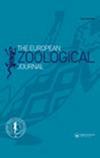A contribution to the phylogeography of Pinctada imbricata radiata (Leach, 1814) (Bivalvia: Pteriidae) from the Eastern Mediterranean Sea by means of the mitochondrial COI marker
引用次数: 8
Abstract
Abstract Pinctada imbricata radiata (Leach, 1814) was the first Lessepsian bivalve reported in the Mediterranean Sea where it is progressively expanding westward. Its native range includes the Indian Ocean and western Atlantic. The present study provides the first insight into the species’ phylogeographic structure, by analysing sequences of a 385-bp region of the mitochondrial gene coding for the subunit I of the cytochrome c oxydase (COI). Sixty-four individuals collected at seven Mediterranean localities were sequenced; in addition, eight COI sequences of individuals from the species’ native range (Persian Gulf) were retrieved from GenBank. Overall, we detected 10 haplotypes. Samples from both the native range and invaded localities were characterised by low levels of haplotype and nucleotide diversity (total h = 0.351, total π = 0.0013). Significant genetic divergence was found between Persian Gulf and Mediterranean Sea samples, whereas very shallow genetic structuring was observed within the Mediterranean study area. Moreover, no pattern of isolation by distance was detected in the Mediterranean. From a historical demography perspective, our results on Mediterranean samples were consistent with a very recent, or even ongoing, demographic expansion. Range expansion of exotic thermophilic species in this area is a widely observed phenomenon that many authors have related to global warming.线粒体COI标记对东地中海平锥虫(双壳亚目:翼类科)系统地理学的贡献
pintada imbricata radiata (Leach, 1814)是在地中海发现的第一个小塞普西亚双壳类,其向西扩张。其原产于印度洋和西大西洋。本研究通过分析编码细胞色素c氧化酶(COI)亚基I的线粒体基因385-bp区域的序列,首次深入了解了该物种的系统地理结构。在地中海7个地点收集的64个个体进行了测序;此外,从GenBank中检索了该物种原生地(波斯湾)个体的8个COI序列。总的来说,我们检测到10个单倍型。来自原生地和入侵地的样本均具有低水平的单倍型和核苷酸多样性(总h = 0.351,总π = 0.0013)。在波斯湾和地中海样本之间发现了显著的遗传差异,而在地中海研究区域内观察到非常浅的遗传结构。此外,在地中海没有发现距离隔离的模式。从历史人口统计学的角度来看,我们对地中海样本的研究结果与最近甚至正在进行的人口扩张相一致。该地区外来嗜热物种的活动范围扩大是一个广泛观察到的现象,许多作者将其与全球变暖联系起来。
本文章由计算机程序翻译,如有差异,请以英文原文为准。
求助全文
约1分钟内获得全文
求助全文

 求助内容:
求助内容: 应助结果提醒方式:
应助结果提醒方式:


